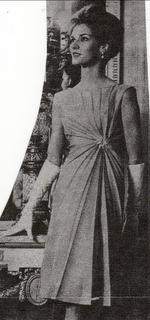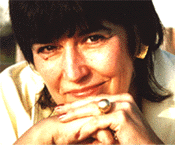

One summer in the mid-60s I was invited to teach fashion design in Florence, Italy for an American college’s program called “Garland in Florence”. At the time I was chair of the fashion department at Mass. College of Art in Boston, so I had many of my own students with me. As a finale for the course we put on a delightful garden fashion show, and I added some of my own designs. It was a grand opportunity to use some of the magnificent Italian fabrics.
These are two of the group I designed. The photos, however, were taken in November, 2004 at my fashion show “Half-Century of Vintage Designs” by a great photographer, Ron Ranere, who also co-organizes the Boston Fashion Industry Meetup with me. It’s a great photographer who can take such good photos when models are concentrating more on moving fast for a show than on the photos. You can see more of Ron’s photos at www.positiveimage-boston.com, and learn more about the Boston Fashion Industry Meetup at http://fashion.meetup.com/1/
The dress on the left is in a four-ply pure silk crepe, and cut on the bias. The big bold black print was very 60s, as was the dress length. The unique feature was the neckline, which I call a “bib”. It was cut as a halter tying in the back, and the front was a few cowls shaped upward to form the bib shape. The dress on the right is in a 100% wool woven with gold and silver threads. The top is cut as a blouson, and the skirt is cut as a yoke skirt. The pleating was formed by tucking in an “umbrella” shape.
S.E.L.F. “Self-Employed Laboratory for Fashion
I’ve been getting a lot of requests from young designers who want both the Stylometrics Pattern System and the instructions on their use for quality, efficient, and fast pattern making. However, I am building a “research laboratory” with a few committed assistants who are self-employed in their own fashion design businesses to test further development. This takes time to make these beautiful for you with instructions for use. So, I beg your patience. I may have some beginning things after the first of the year.
We have agreed on the five primitives, and are in the process of deciding on what generic patterns we will have. Many pieces from my vintage collection will be used to explain some of those generics and how to use them. As, for example, we will have a “generic blouson”, and a “generic yoke skirt”, as developed further in the photo above. Eventually we will have a series of necklines and collars, such as a “generic cowl” neckline. If any of you have specific needs, please email me and let me know. It would help to add those needs into our plans, and you will benefit later.



